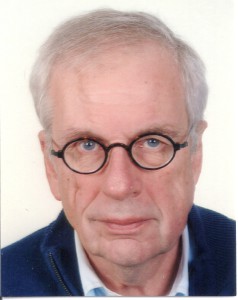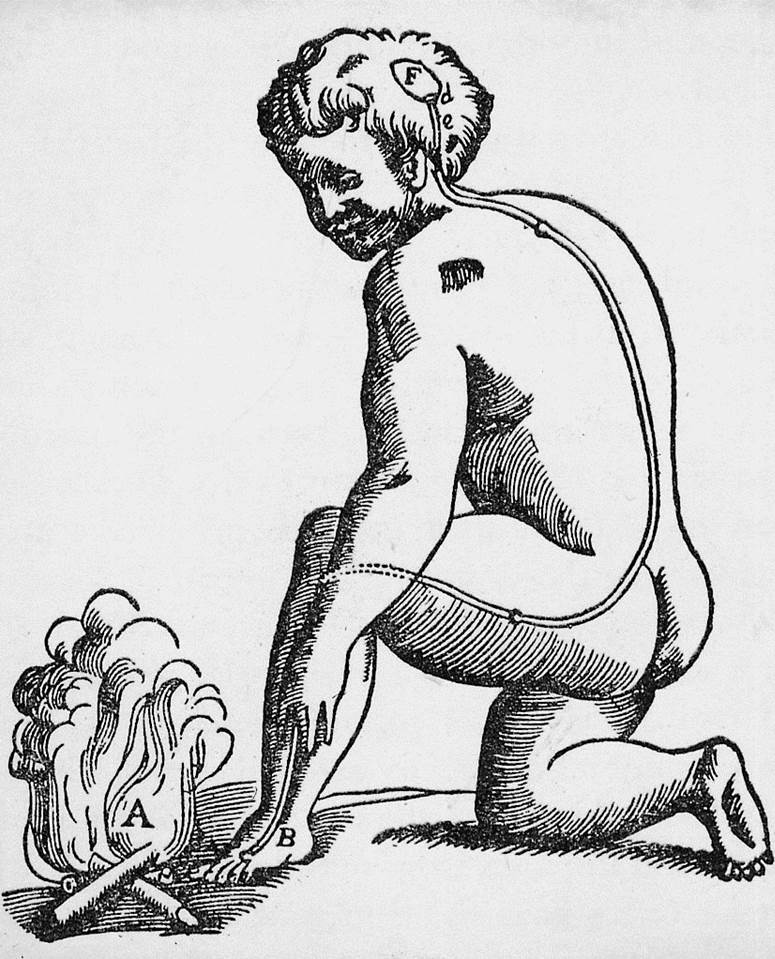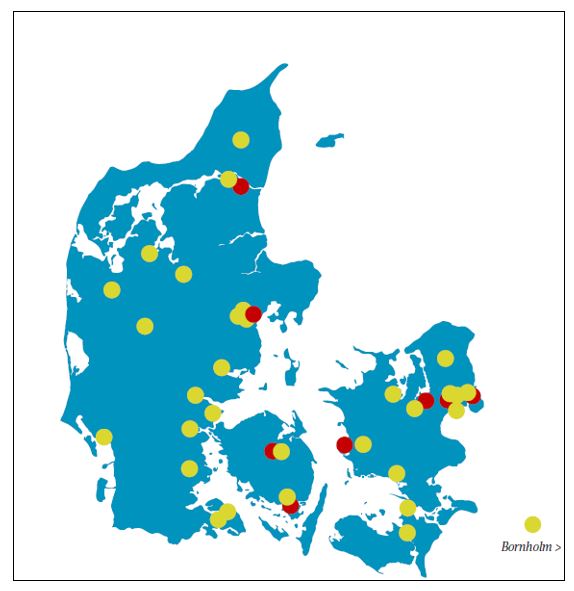
 by Nils Koch-Henriksen and Per Soelberg Sørensen
by Nils Koch-Henriksen and Per Soelberg Sørensen
Denmark has a 100-year history of research in multiple sclerosis (MS), but as everywhere, the number of published studies has grown almost exponentially during the last two decades.
Multiple sclerosis pathological anatomy
One of the significant Danish contributors to multiple sclerosis (MS) research in the 20th century was Torben Fog. His most important publications was about the pathological anatomy of MS lesions in the spinal cord and brain(1;2), based on a collection of brain and spinal cord specimens from autopsies of persons with MS. Torben Fog’s pioneering work was taken up decades later by researchers from the Danish Multiple Sclerosis Center and Department of Neuropathology, Rigshospitalet, who in collaboration with Institute for Brain Research in Vienna, using tissue specimens collected by Torben Fog, studied the dynamic evolution of inflammation and remyelination and found a close association between ongoing inflammation and neurodegeneration. In patients, in whom inflammation had subsided, no sign of ongoing acute axonal damage could be found. They also showed that remyelinated areas had increased vulnerability(3).
The Danish Multiple Sclerosis Registry (DMSR)
In 1948 Dr. Kay Hyllested started his nationwide survey of the occurrence of MS in Denmark where the conditions for were in particular suitable for epidemiologic research because all Danish citizens were kept in the local national registers. Hyllested used multiple sources and estimated the point prevalence in 1949 in Denmark at 65/100,000,(4) and later established the DMSR, which has ever since been continuously updated with virtually complete onset cohorts covering the years from 1948 up to recently. Since 1986 the DMSR has been associated with National Institute for Public Health, Copenhagen and is associated with the Danish Multiple Sclerosis Center, Rigshospitalet, Copenhagen. Later, the Registry was staffed by the neurologists N.K-H and Egon Stenager, who together have authored a number of published papers based on the register.
The DMSR has published a number of studies concerning descriptive epidemiology (prevalence and incidence) and has confirmed that the increasing trend in female incidence (nearly a doubling)(6;7) and sex ratio(8) is also true for the Danish population. A review of the research associated with the Danish MS Registry has recently been published(5).
Follow-up studies. The DMSR is primarily an epidemiological register with no systematic clinical follow-up, but a number of endpoints for all citizens can be achieved by linkage of the DMSG to the Civil Registration System, e.g. vital status and date of death of all deceased MS persons and causes of death. The median survival time in MS patients was 31 years, 10 years shorter than in a matched background population, but survival had improved significantly over decades significantly more than in the matched background population.(9) The risk of suicide among persons with multiple sclerosis was more than twice that of the population.(10) The median time from onset to early pension was 10 years for MS patients versus 24 years for matched controls.(11)
Association studies. Denmark has several population based registers, many of them the under Statistics Denmark. This has enabled a number of register linkage studies where association between certain physical and environmental exposures and the risk of MS have been determined in comparison with the background population. All the below mentioned studies were based on register linkage and not on questionnaires.5
Some examples of “positive” register studies. 1) All persons, registered over decades by a national laboratory with infectious mononucleosis by heterophile andibody test had a 2.7 times increased risk of MS later in life. 2) The risk for MS was increased in first-degree relatives of patients with Hodgkin lymphoma. 3) The risk of developing MS in patients with type 1 diabetes was three-fold increased. 4) The overall risk for cancers was 16% reduced in men. 5) High body mass index in school children carried an increased risk of MS in adulthood. Childbirths apparently carried a decreased risk of onset of in the subsequent five years. Use of antibiotics was associated by an increased risk of MS.
Some examples of “negative” register studies: Formerly suspected risk factors for MS could be exonerated, e.g. socioeconomic status in childhood or in adulthood; childhood infections; head injury; exposure to electromagnetic fields in utility workers; being a nurse or nurse anaesthetist; and exposure to organic solvents.
Treatment Register
The Danish Treatment MS Register was established in 1996 as a separate entity adjoined the Danish MS Registry. It contains prospectively collected data on all patients in Denmark who have received disease modifying therapy. The register is overseen by the Danish Multiple Sclerosis Group representing neurologist from all MS treating centres in Denmark.
A nationwide study comprising 2393 patients, who had started immunomodulatory therapy from 1996 to 2003, reported treatment response in patients treated with various immunomodulatory therapies.(12) Presence of NAbs proved to increase the relapse rates considerably. Studies of the dynamics of NAbs disclosed that NAbs, if present, always occurred within the first 2 years of treatment and that a considerable proportion of patients, in particular patients treated with IFN-beta 1b, became Nab-negative during continued therapy with IFN-beta.(13) It was clearly shown that NAbs hampered the IFN-beta bioactivity and treatment effect on MRI, and, in fact, patients with high titres of NAbs and without in vivo MxA-induction after injection of IFN-beta did not show any differential expression of more than 1.000 genes after an injection of IFN-beta.
The Danish Multiple Sclerosis Center at Rigshospitalet became among the world’s leading centres for measuring NAbs and studying the effect of NAbs that has translated into the publication of “Guidelines on use of Anti-interferon-beta Antibody Measurement in MS” issued by the European Federation of Neurological Societies.(14)
Clinical and translational research (Danish Multiple Sclerosis Center)
During the last 20 years, clinical and translational MS research in Denmark has been centred at the Danish Multiple Sclerosis Center at Rigshospitalet, Copenhagen from which several single-centre and multi-centre clinical trials were initiated and directed. A placebo-controlled trial of plasma exchange combined with azathioprine in secondary progressive MS did not show any effect on MRI lesions. Intravenous immunoglobulin decreased gadolinium enhancing lesions on serial MRI and reduced the number of patients with clinical exacerbations. Two large international placebo-controlled multi-centre trials showed that methylprednisolone as add-on therapy to IFN-beta 1a significantly decreased the number of clinical relapses,(15) whereas simvastatin as add-on therapy to IFN-beta 1a did not show any effect on relapse rate or MRI lesions.(16) In an open-label single-centre study in patients with primary or secondary progressive MS natalizumab decreased CSF biomarkers of inflammation, axonal damage, and demyelination (osteopontin, neurofilament light, and myelin basic protein) and increased the magnetization transfer ratio in both cortical grey and normal appearing white matter.(17) In a small observational study of orally administered Trichuris Suis ova at 2-week intervals for 12 weeks did not show any beneficial effect on serial MRI or relapses.(18)
The Danish Multiple Sclerosis Center was also lead investigator in the first clinical placebo-controlled study of the anti-CD20 monoclonal antibody ofatumumab in relapsing remitting MS that showed a profound effect on MRI activity compared with placebo.
New immunological and translational studies have shown that high CSF concentration of chemokine CXCL13 was associated with disease activity in MS.(19) Increased spontaneous expression of MX1 and other genes associated with IFN-beta activity correlated with the expression of FOXP3 and IL10 expression and were associated with less disease activity on MRI. IFN-beta treatment and endogenous type I IFN activity had similar effect on VLA-4 expression and were associated with control of disease activity.(20) Spontaneous expression of IFN-beta inducible genes in peripheral blood mononuclear cells and treatment with interferon-beta were associated with reduced myelin basic protein-induced T-cell responses in vitro.
A study of 1,161 Danish MS patients revealed that younger age of onset of MS was associated with low exposure of summer sun in adolescence, higher body mass index at 20 years of age.(21)
An early genetic study indicated multiple sclerosis susceptibility loci on chromosomes 5P and 6P21,(22) and a study of co-effected sib pairs from Denmark, Norway and Sweden suggested that disease course an age of onset are partly under genetic control.
By using positron emission tomography to study the cerebral metabolic rate of glucose it was found that both global and regional cortical cerebral metabolic rate of glucose was reduced significantly in MS patients, and correlated with the total lesion area in T2 weighted MRI and cognitive dysfunction,(23) and the cortical cerebral metabolism in MS decreased significantly during a 2 year observation period.
everal important studies of patients with optic neuritis have been made at the MS Clinic, Glostrup Hospital. A controlled trial of oral high dose methylprednisolone in acute optic neuritis showed an improved recovery at 1 and 3 weeks but no difference from placebo could be demonstrated after 8 weeks.(24) Using optical coherence tomography and MRI it was shown that retinal nerve fibre layer thickness was associated with the lesion length in optic neuritis.
Research form University of Aarhus
A research team under University of Aarhus has studied the effect of resistance training in patients with MS. Twelve weeks of intense progressive resistance training of the lower extremities led to improvement of muscle strength and functional capacity, and the effect persisted after 12 weeks.(25) Basal research is outside the scope of this review, but virus research from University of Aarhus has provided studies on the role of endogenous retroviruses, Epstein-Barr viruses, and human herpes viruses.(26)
Reference List
(1) Fog T. [Rygmarvens patologiske anatomi ved dissemineret sclerose og ved dissemineret encephalomyelitis]. Copenhagen: Munksgaard, 1948.
(2) Fog T. The topography of plaques in multiple sclerosis with special reference to cerebral plaques. Acta Neurol Scand Suppl 1965;15:1-161.
(3) Bramow S, Frischer JM, Lassmann H et al. Demyelination versus remyelination in progressive multiple sclerosis. Brain 2010;133:2983-2998.
(4) Hyllested K. Disseminated sclerosis en Denmark: Prevalence and geographical distribution (Doctoral thesis). Copenhagen: J. Jorgensen, 1956.
(5) Koch-Henriksen N, Magyari M, Laursen B. Registers of multiple sclerosis in Denmark. Acta Neurol Scand Suppl 2015;132:4-10.
(6) Koch-Henriksen N, Bronnum-Hansen H, Hyllested K. Incidence of multiple sclerosis in Denmark 1948-1982: a descriptive nationwide study. Neuroepidemiology 1992;11:1-10.
(7) Koch-Henriksen N, Stenager E, Bronnum-Hansen H, Flachs EM. Increasing incidence of Multiple sclerosis in Danish women [abstract]. Mult Scler 2006;12 (suppl 1):S228.
(8) Koch-Henriksen N, Sorensen PS. The changing demographic pattern of multiple sclerosis epidemiology. Lancet Neurol 2010;9:520-532.
(9) Bronnum-Hansen H, Koch-Henriksen N, Stenager E. Trends in survival and cause of death in Danish patients with multiple sclerosis. Brain 2004;127:844-850.
(10) Bronnum-Hansen H, Stenager E, Nylev SE, Koch-Henriksen N. Suicide among Danes with multiple sclerosis. J Neurol Neurosurg Psychiatry 2005;76:1457-1459.
(11) Pfleger CC, Flachs EM, Koch-Henriksen N. Social consequences of multiple sclerosis (1): early pension and temporary unemployment–a historical prospective cohort study. Mult Scler 2010;16:121-126.
(12) Sorensen PS, Koch-Henriksen N, Ravnborg M et al. Immunomodulatory treatment of multiple sclerosis in denmark: a prospective nationwide survey. Mult Scler 2006;12:253-264.
(13) Sorensen PS, Koch-Henriksen N, Ross C, Clemmesen KM, Bendtzen K. Appearance and disappearance of neutralizing antibodies during interferon-beta therapy. Neurology 2005;65:33-39.
(14) Sorensen PS, Deisenhammer F, Duda P et al. Guidelines on use of anti-IFN-beta antibody measurements in multiple sclerosis: report of an EFNS Task Force on IFN-beta antibodies in multiple sclerosis. Eur J Neurol 2005;12:817-827.
(15) Sorensen PS, Mellgren SI, Svenningsson A et al. NORdic trial of oral Methylprednisolone as add-on therapy to Interferon beta-1a for treatment of relapsing-remitting Multiple Sclerosis (NORMIMS study): a randomised, placebo-controlled trial. Lancet Neurol 2009;8:519-529.
(16) Sorensen PS, Lycke J, Eralinna JP et al. Simvastatin as add-on therapy to interferon beta-1a for relapsing-remitting multiple sclerosis (SIMCOMBIN study): a placebo-controlled randomised phase 4 trial. Lancet Neurol 2011;10:691-701.
(17) Romme CJ, Ratzer R, Bornsen L et al. Natalizumab in progressive MS: results of an open-label, phase 2A, proof-of-concept trial. Neurology 2014;82:1499-1507.
(18) Voldsgaard A, Bager P, Garde E et al. Trichuris suis ova therapy in relapsing multiple sclerosis is safe but without signals of beneficial effect. Mult Scler 2015.
(19) Sellebjerg F, Bornsen L, Khademi M et al. Increased cerebrospinal fluid concentrations of the chemokine CXCL13 in active MS. Neurology 2009;73:2003-2010.
(20) Sellebjerg F, Krakauer M, Limborg S et al. Endogenous and recombinant type I interferons and disease activity in multiple sclerosis. PLoS One 2012;7:e35927.
(21) Laursen JH, Sondergaard HB, Sorensen PS, Sellebjerg F, Oturai AB. Association between age at onset of multiple sclerosis and vitamin D level-related factors. Neurology 2015.
(22) Oturai A, Larsen F, Ryder LP et al. Linkage and association analysis of susceptibility regions on chromosomes 5 and 6 in 106 Scandinavian sibling pair families with multiple sclerosis. Ann Neurol 1999;46:612-616.
(23) Blinkenberg M, Rune K, Jensen CV et al. Cortical cerebral metabolism correlates with MRI lesion load and cognitive dysfunction in MS. Neurology 2000;54:558-564.
(24) Sellebjerg F, Nielsen HS, Frederiksen JL, Olesen J. A randomized, controlled trial of oral high-dose methylprednisolone in acute optic neuritis. Neurology 1999;52:1479-1484.
(25) Dalgas U, Stenager E, Jakobsen J et al. Resistance training improves muscle strength and functional capacity in multiple sclerosis. Neurology 2009;73:1478-1484.
(26) Haahr S, Sommerlund M, Moller-Larsen A, Nielsen R, Hansen HJ. Just another dubious virus in cells from a patient with multiple sclerosis? Lancet 1991;337:863-864.
Nils Koch-Henriksen is Professor of Neurology at the Danish MS Research Center – Rigshospitalet, Copenhagen, Denmark
Per Soelberg Sørensen is EAN member at Large and Professor of Neurology at the University of Copenhagen, Rigshospitalet, Copenhagen, Denmark






